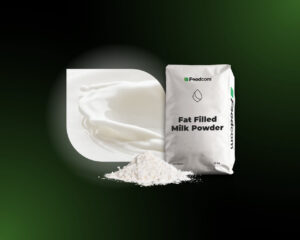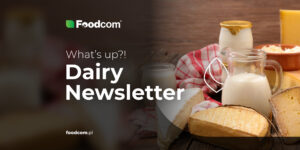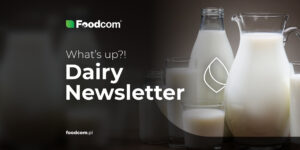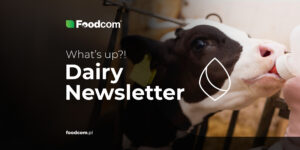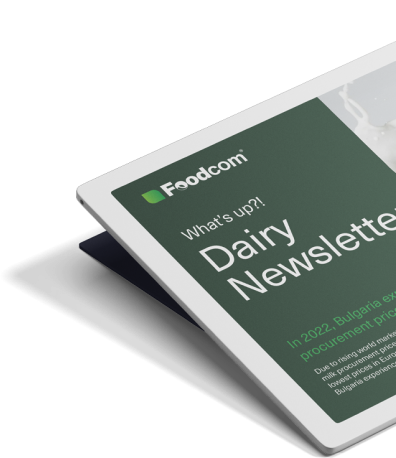- Whey protein isolate prices have reached record levels, while WPC 80 remains stable.
- Skimmed milk powder is seeing slight declines, while feed SMP is on an upward trend.
- Butter prices have weakened, but AMF remains at high levels.
- The cheese market is stable, although falling fat prices may put pressure on producers’ margins.
Welcome Partners!
Welcome back to our newsletter!
Whey protein isolate is hitting record highs above 24000 EUR/MT, while regular WPC 80 stays firm above 10300 EUR/MT. Butter prices are weakening, but AMF remains strong. Cream markets are correcting fast, and skimmed milk powder is under pressure. Meanwhile, cheese prices hold steady – at least for now. Will supply constraints push prices even higher, or is a market shift on the horizon?
Let’s take a look at what has been happening in the dairy market recently!
Milk powders
The European market for skimmed milk powder (SMP) has seen a slight decline in prices, now reaching 2480 EUR/MT. This decline is due to ongoing concerns over foot and mouth disease (FMD), which has affected demand while increasing the availability of supply. Fresh SMP prices remain stable at 2500 EUR/MT, with some lower quality offerings hovering around 2400 EUR/MT, but with limited availability.
The feed SMP market remains stable, with wholesale prices holding at 2420-2470 EUR/MT for Q1, with a slight increase to 2500 EUR/MT for Q2. Prices for concentrated skimmed milk (SMC) of German origin are at 2000-2100 EUR/MT FCA DE. Despite a seasonal increase in milk supply, logistical challenges and cautious demand suggest limited price fluctuations in the near term.
Cheeses
The European cheese market remains stable, with gouda prices at 4300-4400 EUR/MT. Edam is quoted between 4250-4350 EUR/MT, while emmental remains one of the most expensive cheeses, reaching 5200 EUR/MT thanks to high demand for slicing products. Mozzarella and cheddar remain stable at high levels, supported by solid demand and no pressure from producers.
Producers are monitoring possible downward pressure from declining fat prices, which could affect cheese margins. However, demand from the retail and foodservice sectors remains strong, keeping the market balanced.
Fats
The butter market in Europe has weakened, with current prices at 7200-7300 EUR/MT. Q2 contracts have fallen below 7000 EUR/MT, with February-March offers hovering around 7000-7100 EUR/MT. Despite this, retail butter prices in Germany remain well above 8000 EUR/MT, which continues to limit demand.
Anhydrous milk fat (AMF) prices remain high at 9200-9400 EUR/MT, supported by export demand from the confectionery sector. However, rising production costs and falling milkfat prices are likely to exert downward pressure in the coming months.
Liquids
The cream market in Europe has undergone a significant correction, falling sharply from previous highs and now trading in the 8000-8300 EUR/MT range. Increased milk supply and a decline in demand in some sectors have contributed to this decline. However, demand for high-fat cream remains stable in the confectionery and food industry.
Concentrated skimmed milk (SMC) prices remain at 2000-2100 EUR/MT FCA DE, with steady demand from processors. Limited supply due to logistical problems has prevented significant falls in SMC prices, despite an increase in milk availability.
Spot milk prices have weakened slightly at 560-600 EUR/MT. The seasonal increase in milk production is starting to become apparent, which could lead to further price adjustments. However, herd reductions due to bluetongue in some regions may limit supply growth, causing local market imbalances in Q2.
Whey powders
The sweet whey powder(SWP) market in Europe remains stable, with food prices at 1100 EUR/MT and feed prices at 910-940 EUR/MT. Supply and demand are well balanced, with higher liquid whey costs providing solid support for EU prices. However, in the US market, whey prices have weakened due to increasing raw material availability, putting downward pressure on powder prices.
Instant whey protein concentrate(WPC) is trading just above 11000 EUR/MT, with stable demand, particularly from the sports nutrition sector. Standard whey protein concentrate 80(WPC 80) is trading at prices above 10300 EUR/MT. Whey protein isolate(WPI) remains extremely difficult to access, with prices in Europe exceeding 20500 EUR/MT and in some cases reaching as high as 24000 EUR/MT. This market continues to struggle with supply constraints and if current trends continue, further price increases can be expected.
What else?
North America
US President Donald Trump has announced the imposition of 25 per cent tariffs on imports from Canada and Mexico, justifying the decision on the basis of these countries’ inadequate efforts to control the flow of drugs and migration. The new tariffs raise serious concerns for US dairy exporters, as Mexico is the largest market for US dairy products, with the country importing 576,000 tonnes of these products in 2024, accounting for more than 25 per cent of all US exports in the industry. Canada, although a smaller customer, saw a significant increase in the value of US dairy imports, reaching $1.09bn.
In response to the US decision, Canadian Prime Minister Justin Trudeau announced that his country would take “strong and vigorous” retaliatory action if the tariffs go into effect. Mexican President Claudia Sheinbaum warned that “one tariff will trigger another in response”, while expressing a willingness to cooperate with the US on migration and the fight against drug trafficking. Negotiations between the three countries are ongoing, with farmers and US milk exporters calling for a swift resolution to the conflict, which could significantly affect the stability of the North American dairy market.
Asia
Russia has seen a significant increase in the adulteration of dairy products in recent years. Research conducted by the consumer protection organisation Public Control showed that the share of dairy products containing non-dairy ingredients on Russian shop shelves increased by 20-30% in 2023 and 2024. This trend is partly the result of the Russian government halting business inspections indefinitely in March 2022, which many producers perceived as the removal of barriers to food quality control.
An example of this practice is the Balakovo Dairy Plant, which substituted milk fat with fats of non-milk origin without informing about this on product labels. Such practices allow dishonest companies to offer their products 30-40% cheaper than the market average, which poses a serious threat to honest producers. Consumer organisations are calling for tougher penalties and more effective state surveillance activities to combat this practice.
Europe
In the UK, more and more farmers are using DNA testing to take better care of their dairy cow herds. A record number of such tests were carried out in 2024 – the genes of more than 112,000 cows and young heifers (i.e. females who have not yet had calves) were checked . This is up 19% on the previous year.
These tests help breeders select the best cows for further breeding. As a result, herds are healthier, more productive and produce more milk. DNA testing also avoids documentation errors and helps to identify the best genetic traits in animals. According to the AHDB organisation, breeders who regularly use the tests have cows with higher breeding value, which translates into higher profits. This is another step towards modern and more efficient agriculture.
![Protein prices soar, butter dips – dairy markets explained [254th Edition of DAIRY Newsletter] Protein prices soar, butter dips – dairy markets explained [254th Edition of DAIRY Newsletter]](https://foodcom.pl/wp-content/uploads/2023/08/Newsletter_Dairy-1520x760.jpg)
